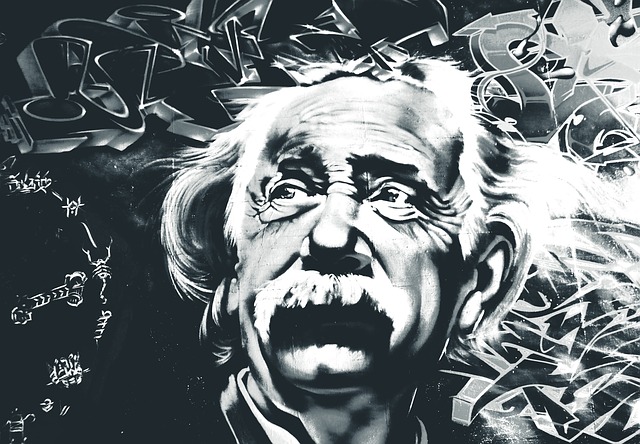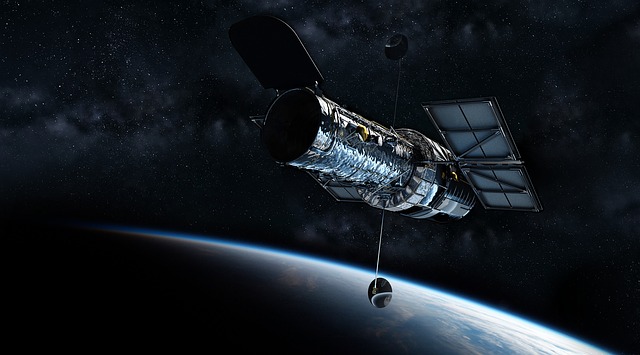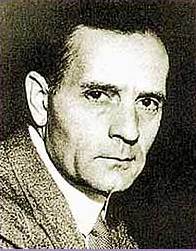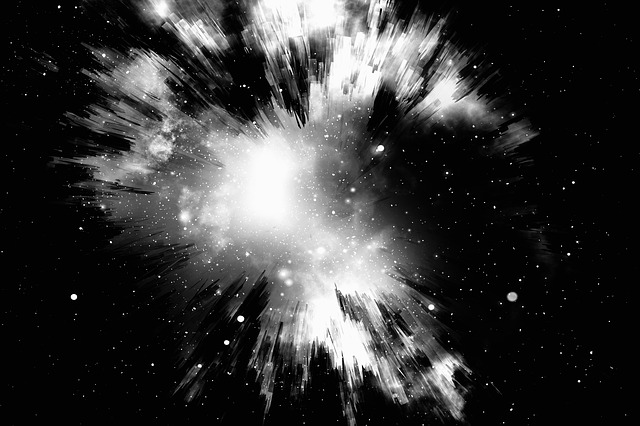Much More is Unknown About our Universe than What is Known
We live in a mysterious Universe – most of which we are unable to see – and its current rate of expansion is believed to be caused by a bizarre substance called Dark Energy. Dark Energy is generally considered to be a property of Space itself, and it first emerged in Albert Einstein’s calculations that formed his Theory of General Relativity.

A New Yardstick For New Physics
It is currently thought that the best explanation for how the Universe came to be is that it was born approximately 13.8 billion years ago in the wild, wonderful, and profoundly mysterious exponential inflation of the Big Bang–whereby it ballooned in size from that of an elementary particle to attain macroscopic size in the tiniest fraction of a second. Spacetime has been growing larger and larger, colder and colder ever since, evolving from its original hot, dense condition, only to expand at a much more stately rate towards its own doom. We inhabit a mysterious Universe–most of which we are unable to see–and its current rate of expansion is believed to be caused by a bizarre substance called Dark Energy. Dark Energy is generally considered to be a property of Space itself, and it first emerged in Albert Einstein’s calculations that formed his Theory of General Relativity (1915).
Nevertheless, much, much more is unknown about our Universe than what is known. In February 2018, astronomers announced that they have used NASA’s Hubble Space Telescope (HST) to make the most precise measurements of the expansion rate of the Universe since it was first calculated nearly a century ago. The intriguing results of these new measurements are forcing astronomers to consider that they may be seeing fascinating evidence of something surprising at work in the Cosmos.
This is because the HST measurements confirm a troubling discrepancy, revealing that the Universe is currently expanding faster than scientists had expected, based on its trajectory seen shortly after the Big Bang. Astronomers now propose that there may be new physics to explain the inconsistency.
“The community is really grappling with understanding the meaning of this discrepancy,” commented lead researcher and Nobel Laureate Dr. Adam Riess in a February 22, 2018 Hubblesite Press Release. Dr. Riess is of the Space Telescope Science Institute (STScl) and Johns Hopkins University, both in Baltimore, Maryland.

Dr. Riess’s team, which also includes Dr. Stefano Casertano (also of STScl and Johns Hopkins), has been making use of the famous Hubble Space Telescope for the past half dozen years in order to render more precise the measurements of the distances to galaxies, using their constituent stars as distance markers. Those measurements are then used to calculate how fast the Universe expands over time, a value termed the Hubble constant. The team’s new study has increased the number of stars analyzed to distances 10 times farther into Space than earlier HST results.
However, Dr. Riess’s new value presents a problem because of the conflict between it and the expected value derived from observations of the primordial Universe’s expansion, 378,000 years after the Big Bang–the violent birth-blast that created the Universe almost 14 billion years ago. Those measurements were made by the European Space Agency’s (ESO’s) Planck satellite, which maps the cosmic microwave background (CMB). The CMB is the relic afterglow of the Big Bang itself, and it reveals wonderful secrets of the Universe’s very beginning to the prying eyes of curious scientists. The difference between the two contradictory values is approximately 9 percent. The new HST measurements help scientists reduce the chance that the discrepancy in the values is a mere coincidence to 1 in 5,000.
The Planck satellite’s results predict that the Hubble constant value should now be 67 kilometers per second per megaparsec, which is 3.3 million light-years, and could be no higher than 69 kilometers per second per megaparsec. This basically indicates that for every 3.3 million light-years farther away a remote galaxy is from us, it is moving 67 kilometers per second faster.
However, Dr. Riess’ team found something else. What they found was a different measured value of 73 kilometers per second per megaparsec. Of course, this is a considerably faster rate than what had been expected. It means that galaxies are galloping along through Spacetime faster than previously indicated by observations of the ancient Universe.
Indeed, the HST data are so precise that astronomers cannot simply shrug off the disquieting, disturbing, and unbelievably intriguing gap between the two differing results as mere errors in any single measurement or method. As Dr. Riess explained in the February 22, 2018 Hubblesite Press Release: “Both studies have been tested multiple ways, so barring a series of unrelated mistakes, it is increasingly likely that this is not a bug but a feature of the Universe.”
The Universe Is Rushing Through Spacetime To Its Own Demise
Star-gazers have stared up at the starlit night sky above Earth for thousands of years, and have asked profound questions concerning the age and size of the Universe. Does the Universe end somewhere; does it have an edge–or does it go on forever, throughout an unimaginable Eternity? Did our Universe have a Beginning? And, if our Universe did, indeed, have a definite and profound Beginning, will it also experience a profound final, fatal End?

In 1929, Edwin Hubble (for whom the famous space telescope is named), made the important discovery that ultimately paved the way for genuinely scientific answers to these previously philosophical questions. Edwin Hubble discovered, when he was working as an astronomer at the California Institute of Technology (Caltech) in Pasadena, that the Universe is expanding. Before Hubble made his discovery, most scientists believed that the Universe is both static and unchanging–and, therefore, not expanding.
Ancient philosophers were the first to ask profound questions about the nature of the Cosmos. For example, the ancient Greeks understood that it was hard to even imagine what an infinite Universe might look like. However, they also pondered the perplexing question that, if the Universe were finite, and you walked off its edge, where would you wind up? The ancient Greeks two unanswered questions created a paradox. The Universe either had to be finite or infinite, and both opposing scenarios presented two extremely difficult problems.
After the rise of modern scientific astronomy, still another paradox began to plague astronomers. In the early half of the 1800s, the German astronomer Heinrich Olbers proposed that the Universe had to be finite. This is because, according to Olbers, if the Universe were infinite, and hosted stars throughout its endless expanse, then if you stared at the sky in any particular direction, your line-of-sight would eventually rest upon the surface of a star. Even though the apparent size of a star sparkling in the sky becomes smaller and smaller as the distance to that particular star increases, the brightness of this smaller stellar surface remains a constant. Therefore, according to this line of reasoning, if the Universe were infinite, the entire surface of the night sky should be as dazzling and brilliant as the surface of a star. This, of course, is not the case. There are obviously dark swaths in the night sky above our planet. Therefore, Olbers reasoned, the Universe had to be finite.
Isaac Newton realized that gravity is always attractive when he discovered the law of gravity. Each and every object in the Universe attracts every other object. Imagine the outcome of this if, indeed, the Universe is finite. Obviously, the mutual gravitational attraction of all the objects inhabiting the Universe, should have caused the entire Universe to collapse in on itself. Of course, this has not happened, and so astronomers were stuck with this truly difficult paradox.
Albert Einstein, as he developed his General Theory of Relativity, also believed that he had been stuck with this seemingly insurmountable problem. Einstein’s equations showed that the Universe should either be collapsing or expanding. However, Einstein, like other physicists of his era, thought that the Universe is static, and his original solution contained a constant term–the cosmological constant. The cosmological constant neatly cancelled out the effects of gravity on the largest scales, and resulted in the desired static Universe. After Hubble discovered that the Universe is not static, but expanding, Einstein reportedly called the cosmological constant his “greatest blunder.”

Larger telescopes were being built around the same time, and they were able to precisely measure the spectra (the intensity of light as a function of wavelength) of dim objects. Astronomers, using this newly acquired data, tried to understand the myriad faint, nebulous objects they were now able to see with the new telescopes. Between 1912 and 1922, astronomer Vesto Slipher of the Lowell Observatory in Arizona found that the spectra of light traveling from a large number of these objects was systematically shifted to longer wavelengths (redshifted). Soon thereafter, other astronomers were able to demonstrate that these nebulous faint objects were remote galaxies beyond our own. Our spiral Galaxy, the Milky Way, was not an island at all–as had been previously thought–it had plenty of company. In fact, our Galaxy is only one of billions dancing through the relatively small swath of the Universe that we can observe–the observable Universe. Whatever may reside beyond the observable Universe is beyond the horizon of our visibility because the light streaming out from those unimaginably remote regions has not had time to reach us since the Big Bang almost 14 billion years ago. No known signal can travel faster than light in a vacuum, and so the speed of light sets something of a universal speed limit.
During this same highly productive era in the history of astronomy, other mathematicians and physicists working on Einstein’s General Relativity, found that the equations contained some solutions that described an expanding Universe. In these solutions, the light traveling from distant objects would be redshifted as it streamed its sparkling way through expanding Spacetime. Thus, the redshift would increase with increasing distance to the object emitting the light.
In 1929, Edwin Hubble measured the redshifts of many distant galaxies. He also went on to measure their relative distances by measuring the apparent brightness of a special class of variable stars called Cepheids inhabiting each galaxy. When Hubble plotted redshift against relative distance, he discovered that the redshift of remote galaxies increased as a linear function of their distance. There could be only one explanation for this observation: the Universe is expanding.
When astronomers came to the realization that the Universe is expanding, they immediately understood that it had to have been smaller in the past. At some point in the past, they calculated, the entire Universe would have been a single point. This point, later called the Big Bang, was the beginning–the birth–of the Universe as we understand it today.
Therefore, the Universe is finite, in both Space and Time. The reason that the Universe did not collapse in on itself, as both Newton’s and Einstein’s equations indicated, is that it had been expanding from the moment of its birth. The Universe is in a constant state of change–it is not static. The expanding Universe, a relatively new idea in modern physics, put an end to the nagging paradoxes that haunted the sleepless nights of many scientists from the time of ancient philosphers until the early 20th century.
We live in a mysterious Universe–most of which we cannot see with our human eyes. The galaxies, clusters of galaxies, and superclusters of galaxies are all nested in halos composed of a strange transparent form of non-atomic matter that scientists refer to as dark matter. This unidentified material is much more abundant than the atomic matter that composes the Universe we are familiar with–stars, planets, moons, trees, and people, for example. On large scales, the entire Universe looks the same wherever we turn our eyes–displaying a bubbly, foamy appearance, with very heavy dark matter filaments that twist and wind themselves around each other, weaving a web-like structure that is (appropriately) referred to as the Cosmic Web. Though invisible, the filaments of the Cosmic Web are outlined by the seductive sparkle of a multitude of stellar fires. The stars trace out immense sheets and intertwining braids that host the stellar-studded galaxies inhabiting the observable Universe.
The temperature throughout the original Big Bang fireball was almost but not precisely uniform. This exquisitely tiny variation from exact uniformity is responsible for the formation of everything we are and all that we can ever know. Before the period of inflation occurred, the extremely small, elementary-particle-sized Patch–that eventually expanded to become the Universe–was completely homogeneous, smooth, and appeared to be the same in every direction. The primeval period of inflation is thought to explain how that originally homogeneous Patch began to ripple. The tiny fluctuations, the primordial ripples in Spacetime, occurred in the smallest units that can be measured (quantum). Inflation explains how these quantum fluctuations in the baby Universe eventually grew to become large-scale structures like galaxies, galaxy clusters, and superclusters. Wherever we look when we observe the Universe, we see exactly the same thing. This has been interpreted to mean that at one extremely ancient time everything was squashed into a tiny point where everything was in contact with everything else. At the birth of Spacetime, every region was in contact with every other region.

Imagine the Universe as a rising loaf of poppyseed bread. As the leavening dough begins to rise (inflate), the poppyseeds become increasingly farther and farther away from each other. If this kitchen drama were played backwards, the dough would shrink, and all of the poppyseeds would be on top of one another.
Shrouded In Darkness
Dr. Adam Riess suggests a few potential explanations for the faster-than-expected expansion of the Universe–and all are related to the 95% of the Cosmos that is shrouded in mysterious darkness. One of the possibilities proposed by Dr. Riess is that the dark energy, that is already known to be accelerating the Universe’s expansion, may be pushing galaxies away from each other with even greater–or ever growing–force. This essentially means that the acceleration itself may not really have a constant value. Instead, the accelerating expansion of the Universe may change over time. Dr. Riess shared the Nobel Prize in Physics for the 1998 discovery of the accelerating expansion of Spacetime.
Yet another proposal suggests that the Universe hosts a new subatomic particle that flies shrieking through Spacetime at almost the speed of light. Such swiftly galloping particles are collectively termed “dark radiation”, and it includes previously unknown particles such as neutrinos. Neutrinos are formed in nuclear reactions and radioactive decays. Unlike a normal neutrino, which interacts by way of a subatomic force, the new particle would be influenced only by gravity. This is the reason why it is dubbed a “sterile neutrino”.
Yet another (especially intriguing) proposal is that the invisible non-atomic dark matter particles interact more strongly with normal atomic (so-called “ordinary) matter than previously hypothesized.
Any one of these theories would change the contents of the primordial Universe, thus leading up to inconsistencies in theoretical models. These inconsistencies would result in an incorrect value for the Hubble Constant, as calculated from observations of the baby Universe. The value would thus differ from the HST observations.
So far, Dr. Riess and his colleagues don’t have an answer to this nagging problem. However, his team plans to continue working on fine-tuning the Universe’s expansion rate. At this time, Dr. Riess’ team, called the Supernova H0 for the Equation of State (SHOES), has decreased the uncertainty to 2.3 percent. Before HST was launched back in 1990, estimates of the Hubble Constant differed by a factor of two. One of HST’s primary goals was to aid astronomers in their efforts to reduce the value of the uncertainty to within an error of only 10%. Since 2005, the group has been seeking to refine the accuracy of the Hubble Constant to a precision that allows for a better comprehension of the Universe’s mysterious behavior.

The team of astronomers has been successful in refining the value of the Hubble Constant by both strengthening and streamlining the building of the cosmic distance ladder. Astronomers use the cosmic distance ladder to accurately measure distances to galaxies that are both near to and far from our planet. The astronomers have compared those distances with the expansion of Spacetime as measured by the stretching of traveling light streaming out from galaxies moving away from Earth. The scientists then went on to use the apparent outward velocity of galaxies at each distance to calculate the Hubble Constant.
However, the value of the Hubble Constant is only as precise as the accuracy of the measurements. In order to achieve the necessary accuracy, astronomers have chosen special classes of stars and supernovae to use as cosmic yardsticks or milepost markers to accurately measure galactic distances.
Cepheid variable stars are the most reliable yardsticks for astronomers to use when measuring shorter distances. Cepheid variables are pulsating stars that brighten and dim at rates that correspond to their intrinsic brightness. As a result, their distances can be calculated by comparing their intrinsic brightness with their apparent brightness as observed from our planet.
The most recent HST result is based on measurements of the parallax of eight newly studied Cepheids in our own Milky Way Galaxy. These variable stars are approximately 10 times more distant than any previously studied Cepheids, situated between 6,000 light-years and 12,000 light-years from Earth–thus rendering them more difficult to measure. These Cepheids pulsate at longer intervals, just like the Cepheids observed by HST inhabiting remote galaxies hosting another reliable cosmic yardstick–brilliantly exploding stars called Type Ia supernovae. This particular type of supernova blazes with uniform brightness and is sufficiently dazzling to be observed from relatively farther away. Earlier HST observations studied 10 more-rapidly-blinking Cepheids situated 300 light-years to 1,600 light-years from Earth.
In order to measure parallax with HST, the astronomers had to determine the apparent tiny wobbles of the Cepheids caused by Earth’s orbit around our Sun. These tiny wobbles are about the size of 1/100 of a single pixel on the space telescope’s camera, which is approximately the apparent size of a grain of sand seen by an observer standing 100 miles away.
Therefore to ensure the accuracy of the measurements, the scientists developed an ingenious method that was unknown at the time HST was launched. The astronomers developed a scanning method in which the HST measured a star’s position a thousand times per minute every six months for four years.
The team then calibrated the true brightness of the eight slowly pulsating Cepheids and cross-correlated them with their more remote winking siblings to tighten the inaccuracies in their distance ladder. Then the astronomers compared the brightness of the Cepheids and supernovae in those galaxies with improved confidence. In this way, they could more precisely measure the star’s true brightness, thus calculating distances to hundreds of supernovae in remote galaxies more precisely.
The new technique involves HST slowly sliding across a targeted star, thus obtaining the image as a streak of light. The advantage of this technique allows for repeated opportunities to measure the extremely tiny displacements resulting from parallax. The astronomers measure the separation between two stars, not only in one place on the camera, but over and over thousands of times, thus reducing errors in measurement.
The team’s goal is to further reduce the uncertainty by using data obtained from HST and the European Space Agency’s (ESA’s) Gaia Space Observatory. This will measure the positions and distances of the variable stars with unprecedented precision.
As Dr. Casertano commented in the February 22, 2018 Hubblesite Press Release: “This precision is what it will take to diagnose the cause of this discrepancy.”
The new research will be published in The Astrophysical Journal.
Judith E. Braffman-Miller is a writer and astronomer whose articles have been published since 1981 in various newspapers, magazines, and journals. Although she has written on a variety of topics, she particularly loves writing about astronomy because it gives her the opportunity to communicate to others some of the many wonders of her field. Her first book, “Wisps, Ashes, and Smoke,” will be published soon.
Article Source: A New Yardstick For New Physics
